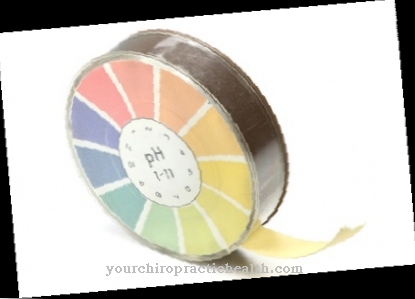A Foreign body aspiration occurs when foreign bodies enter the respiratory organs and passages. In the majority of cases, foreign body aspiration occurs in young children. In principle, however, it is possible that the aspiration of foreign bodies occurs in people of all ages. In the majority of patients, foreign body aspiration occurs during the ingestion of food.
What is foreign body aspiration?

© Kzenon - stock.adobe.com
Foreign body aspiration differs in individual cases in terms of its severity and its potential for complications. The symptoms primarily depend on what type of foreign body and how deeply it has penetrated the airways. The first sign of aspiration is usually a wheezing sound when you breathe.
If the airways are severely obstructed, patients suffer from a cough that can no longer be stopped. In numerous cases, so-called hemoptysis also develop. If the supply of fresh air is severely impaired by aspiration of the foreign body, many affected people develop cyanosis or dyspnea.
causes
The cause of a foreign body aspiration is basically that an object enters the airways. For example, parts of the food or toys are possible. In many cases, foreign bodies are aspirated by young children who, for example, inhale various solids while eating or playing. Possible objects include bones, nuts, stones or parts of the toys.
In adults, aspiration of foreign substances occurs primarily in situations in which the patient suffers from neurological disorders or is unconscious. As a result, the process of swallowing is impaired in many cases. Observations also show that the inhalation of foreign bodies is often not noticed. This applies equally to child and adult patients.
You can find your medication here
➔ Medication for shortness of breath and lung problemsSymptoms, ailments & signs
A foreign body aspiration is generally associated with various symptoms that differ slightly in each patient. Basically, the individual complaints that arise depend heavily on three factors. These include the location of the foreign substance within the airways, the type and size of the foreign body and the time span between inhalation and the diagnosis.
With regard to the localization of the inhaled foreign body, it can be seen that the majority of foreign body aspirations are concentrated in the bronchi. Often the foreign bodies get stuck in the bronchial branches on the right side. The reason for this is that the main bronchial path on the right descends more steeply than the one on the left.
With regard to the foreign body, the type, shape, size and constancy of the foreign matter are primarily decisive. If the substances are contaminated, the risk of infections of the respiratory tract increases considerably. In this context, for example, so-called aspiration pneumonia is possible.
Depending on its size and shape, the foreign matter may completely block the bronchial pathways. In some cases, this leads to atelectasis. In other cases, the foreign body acts as a kind of valve, whereby air can be inhaled but not exhaled. There is a risk of overinflation.
After all, the period between the foreign body aspiration and the diagnosis plays an important role in the development and severity of symptoms and complications. The more time it takes to diagnose, the more likely it is that difficulties will develop from aspiration of the foreign body.
Above all, this increases the risk of superinfections. Inflammatory processes in the affected airways and the surrounding areas also develop more easily. If the foreign substance is not removed from the airways, atelectasis and hemoptysis develop in many cases.
diagnosis
Foreign body aspiration is diagnosed based on the symptoms present. First, the doctor conducts a conversation with the patient, analyzing the symptoms as well as the causes and circumstances of the aspiration. Then the doctor examines the patient using different methods.
Usually the physical exam comes first, with the doctor examining the person's throat, for example. Another important method is imaging, which usually enables a reliable diagnosis of foreign body aspiration. In most cases, the chest area is X-rayed. In some patients, spirometry is also used to confirm the diagnosis.
Complications
In the worst case scenario, foreign body aspiration can lead to death. A very quick and professional treatment by the emergency doctor is necessary here so that the patient does not die. Death occurs due to the reduced supply of oxygen. Since foreign body aspiration can occur in age groups alone and with different objects, the complications are very different.
Panic attacks and gasping breathing occur in general. The organs and extremities are supplied with less oxygen and can be damaged in the process. The longer the undersupply takes place, the more they are damaged. The brain in particular can be severely affected, so that after the foreign body has been removed, mental or psychological impairments can occur.
The risk of foreign body aspiration is particularly high in small children and babies. It usually takes 13 minutes for the patient to die without oxygen. Before that he loses consciousness. It is not uncommon for surgical interventions to be necessary to remove the foreign body. If the foreign body is swallowed completely, it can lead to problems in the stomach.
It depends to a large extent on the foreign body itself whether it has to be removed surgically. Further complications can occur if toxic substances get into the oral cavity and thus into the body during foreign body aspiration.
When should you go to the doctor?
If you experience difficulty breathing, you should always consult a doctor. A doctor will be needed if shortness of breath or inability to breathe deeply. If the person concerned accidentally inhaled objects, urgent action is required. This is also the case when food or liquids are absorbed into the windpipe. If the foreign bodies get into the lungs, they can cause irreparable tissue damage. This has a significant impact on the lungs.
In severe cases, organ failure occurs, which, without early medical treatment, ends with the death of the person concerned. In addition, the foreign objects in the lungs can cause pneumonia. This, too, can have a fatal outcome without the fastest possible medical care.
If there is persistent scratching of the windpipe or the spitting up of blood, a doctor should be consulted. If the blood pressure rises or the heart starts racing, a doctor's visit is necessary. Dizziness, vomiting, or nausea are signs that should be checked by a doctor.
If there is a loss of consciousness, an emergency doctor must be called. The sequelae of foreign body aspiration have triggered a critical health condition that must be treated immediately by intensive care. If there is a fever, panic or hysterical behavior, a doctor is needed. The behavior worsens the situation, so that help is urgently needed.
Doctors & therapists in your area
Treatment & Therapy
Foreign body aspiration is usually treated by removing the relevant foreign substance from the airway area. In some cases, a bronchoscopy is used for this purpose, whereby the foreign body is removed from the airways with the help of a tube. In some patients, however, this method is impractical due to the location of the foreign body or other factors.
In such cases, surgical interventions may be necessary to remove the foreign body. Antibiotics may be given to patients with aspiration pneumonia. In principle, a timely diagnosis of the foreign body aspiration and a quick subsequent removal of the foreign substance significantly improve the prognosis for the affected patient.
Outlook & forecast
In the case of foreign body aspiration, the prognosis depends on the parameters age, location of the foreign body and size of the foreign body inhaled. In the best case scenario, the foreign body can simply be coughed up or removed from the trachea by the doctor. In the event of breathing difficulties due to an unfavorable position or a larger size of the foreign body, an emergency doctor must be called immediately. There is a risk of suffocation.
If it is not the upper but rather the deeper airways that are affected by foreign body aspiration, the prognosis is rather poor. At first it can appear as if everything went well. The inhaled foreign body can cause inflammation in the bronchial tissue or get stuck in the windpipe. If he starts moving again while coughing, there is an acute need for action.
Foreign body aspiration is particularly dangerous for the elderly or disabled and small children. The pure suspicion of a foreign body aspiration should therefore lead to an immediate doctor's visit. The prognosis improves if the doctor visit is quick. This can prevent injuries and inflammation. If necessary, the doctor can remove the foreign body that has been inhaled.
The longer the doctor's visit is delayed, the worse the prognosis. The foreign body can grow in and cause severe inflammatory reactions. The inflammation then often requires antibiotic therapy. If necessary, the foreign body must be surgically removed. Clinical surveillance is required in severe cases of foreign body aspiration that result in injury.
You can find your medication here
➔ Medication for shortness of breath and lung problemsprevention
Foreign body aspiration prevention focuses on avoiding the inhalation of foreign substances. Above all, attention is required, for example when eating.
Aftercare
In most cases, no follow-up care is necessary for foreign body aspiration. Removing the item that has got into the throat is usually sufficient. If necessary, subsequent sore throats are treated with sprays, lozenges or rest. If there is a minor injury, it is advisable to avoid solid, hard food for a while and to drink neither too cold nor too hot drinks.
Follow-up care is only possible in two cases: On the one hand, there is the surgical intervention. This may be necessary due to the position of the foreign body or due to a tilt in the neck. Follow-up care is the same as for all other, smaller surgical interventions.
It essentially consists in observing the healing process over a short period of time and in caring for the wound or suture. A follow-up examination is rarely necessary. In the case of major injuries due to foreign body aspiration, multiple follow-up checks may be necessary in order to assess the healing and, if necessary, to intervene medically.
Otherwise, it can also make sense to prescribe antibiotics for follow-up care to prevent subsequent infections. These could be caused by the object itself, if it was contaminated, or the attacked tissue appears to the doctor as susceptible to infection.
You can do that yourself
Since foreign body aspiration occurs mainly in children, the parents or supervisors are primarily responsible for the relief measures that are carried out at home. However, since a foreign body should always be removed from the airways, the possibilities for self-help are limited to the correct behavior in the event of a foreign body aspiration.
If the person swallowing can still breathe, they should not be patted on the back. Also, the object should not be tilted upside down and the object should not be shaken out. Both of these involve the risk that the object will shift and lead to serious problems in the new position. A removal in a hospital is desirable.
Only when the person swallowing can no longer breathe should an attempt be made to force the object out of the airways with gentle force. For this purpose, the head-down position and tapping between the shoulder blades are ideal. It may be necessary to give mouth-to-mouth resuscitation and chest compressions until the emergency doctor arrives.
Ventilation and chest compressions must be carried out in any case in the event of suspended breathing - regardless of whether the supervisors are confident enough to do so. In the event of impending suffocation, it is imperative to act immediately




.jpg)

.jpg)


















.jpg)

.jpg)
